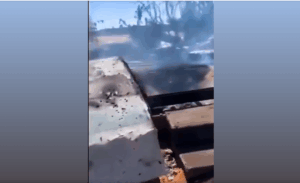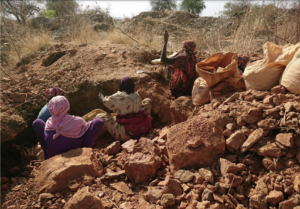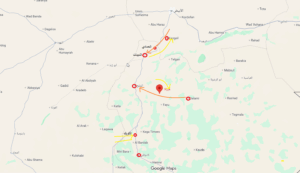Renewed Blue Nile state clashes kill another 13 in Sudan
The conflict in Blue Nile state flared up again on October 13, leaving at least 13 people dead and 24 injured after a land dispute in Wad El Mahi locality, the United Nations Office for Humanitarian Affairs (OCHA) published in a flash update on the conflict yesterday. Intercommunal violence in the area saw at least 162 people killed since July.
 Victims of the clashes in Um Darfa, Blue Nile state, in September (social media)
Victims of the clashes in Um Darfa, Blue Nile state, in September (social media)
The conflict in Blue Nile state flared up again on October 13, leaving at least 13 people dead and 24 injured after a land dispute in Wad El Mahi locality, the United Nations Office for Humanitarian Affairs (OCHA) published in a flash update on the conflict yesterday. Intercommunal violence in the area saw at least 162 people killed since July.
OCHA's full update can be read here.
The intercommunal violence that erupted in mid-July between Hausa, Berta, El Hamaj, and other ethnic groups in the northern part of Blue Nile state, which left at least 105 people dead and caused thousands to flee to the state's capital Ed Damazin and safe parts of El Roseires, has flared up before. In September, at least 24 people were killed as the violence resurfaced. At 149 people died before October 6, according to OCHA.
According to unconfirmed reports, two people from El Hamaj tribe were killed in a land dispute in Wad El Mahi locality on October 13, OCHA writes. This led to clashes between the Hausa community and other tribes in the areas that lasted until October 16, in which at least another 13 people died. The situation is reportedly still "tense and unpredictable".
There are unconfirmed reports that an estimated 1,200 people have been displaced and are taking refuge in schools and in a nearby camp for the displaced, OCHA reported. Markets have closed due to the conflict so local residents are struggling to meet their basic daily needs. Government offices are also closed.
'The situation is still tense and unpredictable' – OCHA
State authorities have imposed movement restrictions, and there is no movement between Ed Damazin and Wad El Mahi despite the heavy deployment of security forces, the UN office wrote. The area is currently inaccessible to humanitarian organisations. OCHA said that revenge attacks remain possible "at any time".
Field teams from the International Organisation for Migration (IOM) report that the Hausa have reportedly been expelled from the area by the El Jabalaween tribe, who are on the side of the Berta.
"Humanitarian partners continue to deliver life-saving assistance to the displaced and vulnerable people they can reach who have been affected by the conflict," OCHA wrote.
Conflict background: political stakes
The violence in July was partly triggered by conflicts of land ownership and control, though experts said that the Khartoum government was partly to blame.
Those clashes allegedly erupted after the Hausa requested the establishment of a "civilian authority" that the other ethnic communities viewed as a means of gaining access to the land.
The El Roseires Resistance Committees, however, described the violence in July as a manifestation of the hostility between the two factions of the Sudan People’s Liberation Movement-North (SPLM-N) that split in 2017 following a leadership rift and social media activists blamed the SPLM-N Agar (under the leadership of Malik Agar) of worsening the situation.
The Communist Party of Sudan said that “the explosive situation in the southern Blue Nile region comes as a result of the attempts of the leadership of the Sudan People’s Liberation Movement-North faction led by Malik Agar (SPLM-N Agar) to seize power and disrupt the fragile peace in the region".
The resistance committees also accused the authorities of neglecting their duties because they ignored warning signs and chose not to act even after the first attacks. The Forces for Freedom and Change-Central Council (FFC-CC) also blamed the authorities and said that “there are historical roots for these violent events, but that they could be ignited these days is because of the absence of a national project of the coup authority, which lacks any popular political support”.
Kholood Khair, leading member of a think-and-do tank in Khartoum, viewed the violence from a different angle: “This is a gold rush and a building of war chests by the emerging ethnic blocs of El Burhan and the Centre vs Hemeti and the Periphery, giving a radically militarised trajectory to Sudan's political future”.
The clashes also sparked protests across Sudan, as the Hausa people demanded justice for the dead. Most of the demonstrations remained peaceful, but the protests in Kassala in eastern Sudan turned into bloody clashes after angry young Hausa torched government offices in the city. Five of them reportedly died.
Recently, Hausa youth planned a protest escalation to demand the dismissal of the governor of Kassala after he refused to implement the terms of a memorandum they submitted asking to investigate the killings of the five Hausa protesters. They also demanded the release of all those detained during the protest.
Racism
The Hausa in Sudan are part of the Hausa ethnic group, which is very influential in West Africa, politically and culturally. In the process of traveling and trading for centuries, some of them migrated east to places like Sudan – where they, as ‘black Africans’, are still seen by many as outsiders.
Some activists, for example, tweeted that the Hausa demonstrators in other cities marching in solidarity with the Hausa experiencing violence in Blue Nile state did not receive much support.
“It was heart-breaking to watch the Hausa march alone. I expected more people to show up and tell them “you will never walk alone”, “we’re all Hausa” as resistance committees usually do, instead I noticed a lot of hostility and outright racism,” one of them said about a Hausa solidarity protest in Khartoum.











 and then
and then